Finance 10 Assignment: Annuity, Time Value, and Bonds Analysis
VerifiedAdded on 2022/10/09
|10
|1951
|25
Homework Assignment
AI Summary
This finance assignment explores several key concepts including retirement annuities, time value of money, and bond valuation. The assignment begins by calculating the monthly payment for a retirement annuity, comparing the lump-sum option with monthly installments, and considering the impact of the annual percentage rate (APR). The second question focuses on planning for college tuition, determining the annual deposit needed to cover costs, and evaluating the financial benefits of a daughter skipping a grade. The assignment then delves into the time value of money, comparing different investment options and calculating their present values. Finally, the assignment analyzes bonds, determining their minimum selling price and duration at the time of sale, incorporating concepts like coupon payments and yield to maturity. The solution provides detailed calculations and explanations for each section, offering a comprehensive understanding of these financial principles.

RUNNING HEAD: FINANCE 1
UNIVERSITY NAME
STUDENT NAME
STUDENT ID
COURSE
DATE
UNIVERSITY NAME
STUDENT NAME
STUDENT ID
COURSE
DATE
Paraphrase This Document
Need a fresh take? Get an instant paraphrase of this document with our AI Paraphraser

FINANCE 2
EXECUTIVE SUMMARY.
The purpose of this report is to determine the amount of retirement annuity that an individual can
receive when paid all of them at once or when paid in instalment.it also highlight the difference
in value when paid once or in full at once.it also assist in the determination of the annual deposit
to be made in order to achieve the desired goal of saving for the high school tuition fees and the
amount of money that can be saved or lost if the daughter can skip one grade in high school and
commence college one year sooner.it also highlights the concept of time value of money by
evaluating three options A,B and C.And coming up with the best option to choose.
This report also determines the selling price and the duration of the bond at the time of sale.
EXECUTIVE SUMMARY.
The purpose of this report is to determine the amount of retirement annuity that an individual can
receive when paid all of them at once or when paid in instalment.it also highlight the difference
in value when paid once or in full at once.it also assist in the determination of the annual deposit
to be made in order to achieve the desired goal of saving for the high school tuition fees and the
amount of money that can be saved or lost if the daughter can skip one grade in high school and
commence college one year sooner.it also highlights the concept of time value of money by
evaluating three options A,B and C.And coming up with the best option to choose.
This report also determines the selling price and the duration of the bond at the time of sale.

FINANCE 3
Table of Contents
INTRODUCTION.......................................................................................................................................4
QUESTION 1..............................................................................................................................................4
RETIREMENT ANNUITY.....................................................................................................................4
PART A...............................................................................................................................................4
QUESTION 2..............................................................................................................................................5
PART A...................................................................................................................................................5
PART B...................................................................................................................................................5
QUESTION 3..............................................................................................................................................5
TIME VALUE OF MONEY...................................................................................................................5
ANNUAL PERCENT RATE(APR)........................................................................................................6
option A...............................................................................................................................................6
Option B..............................................................................................................................................6
Option C..............................................................................................................................................7
QUESTION 4..............................................................................................................................................7
Bonds.......................................................................................................................................................7
Coupon....................................................................................................................................................8
Determination of minimum selling price of the bond..........................................................................8
Determination of the duration at the time of selling the bond.............................................................9
CONCLUSION...........................................................................................................................................9
REFERENCES..........................................................................................................................................10
Table of Contents
INTRODUCTION.......................................................................................................................................4
QUESTION 1..............................................................................................................................................4
RETIREMENT ANNUITY.....................................................................................................................4
PART A...............................................................................................................................................4
QUESTION 2..............................................................................................................................................5
PART A...................................................................................................................................................5
PART B...................................................................................................................................................5
QUESTION 3..............................................................................................................................................5
TIME VALUE OF MONEY...................................................................................................................5
ANNUAL PERCENT RATE(APR)........................................................................................................6
option A...............................................................................................................................................6
Option B..............................................................................................................................................6
Option C..............................................................................................................................................7
QUESTION 4..............................................................................................................................................7
Bonds.......................................................................................................................................................7
Coupon....................................................................................................................................................8
Determination of minimum selling price of the bond..........................................................................8
Determination of the duration at the time of selling the bond.............................................................9
CONCLUSION...........................................................................................................................................9
REFERENCES..........................................................................................................................................10
⊘ This is a preview!⊘
Do you want full access?
Subscribe today to unlock all pages.

Trusted by 1+ million students worldwide
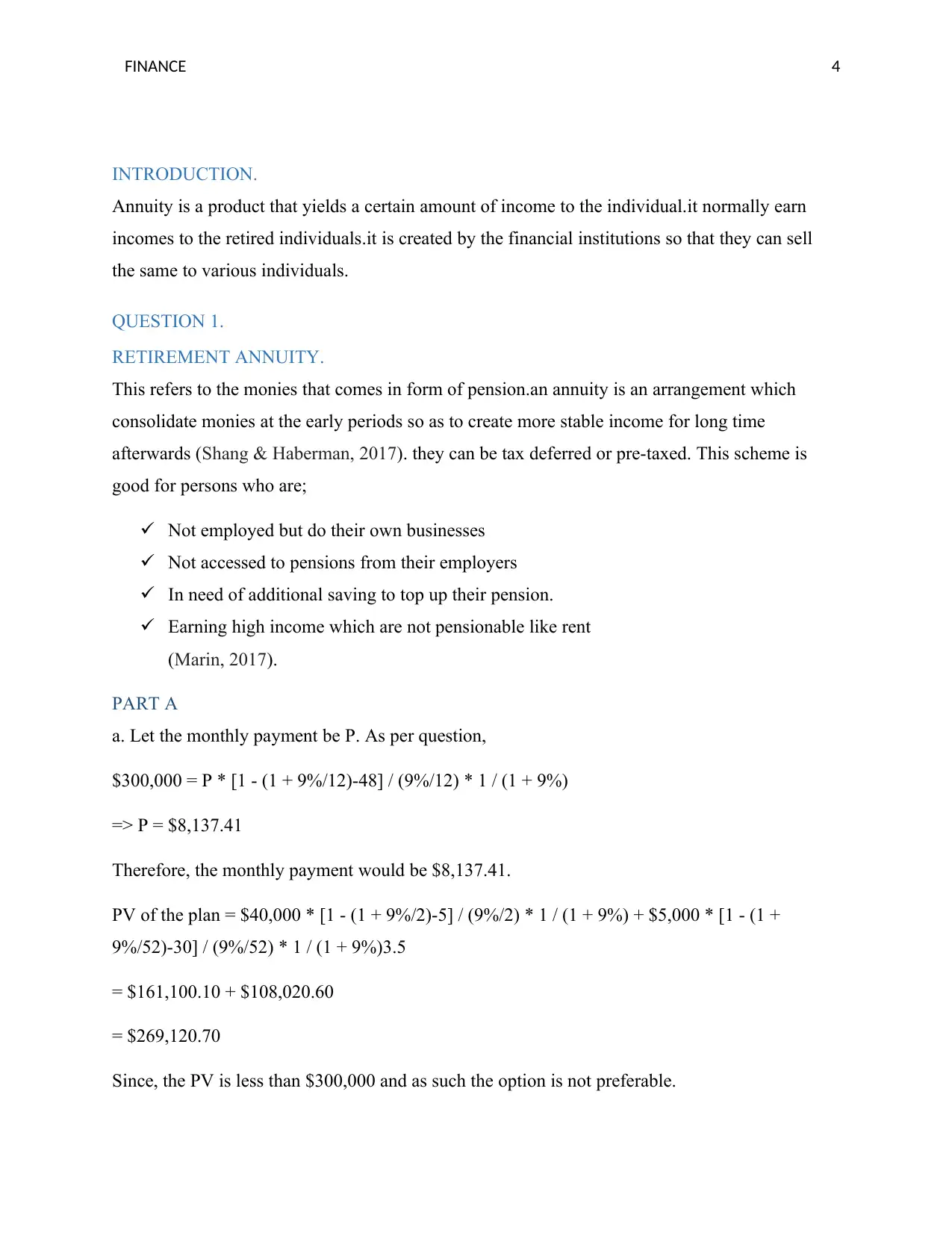
FINANCE 4
INTRODUCTION.
Annuity is a product that yields a certain amount of income to the individual.it normally earn
incomes to the retired individuals.it is created by the financial institutions so that they can sell
the same to various individuals.
QUESTION 1.
RETIREMENT ANNUITY.
This refers to the monies that comes in form of pension.an annuity is an arrangement which
consolidate monies at the early periods so as to create more stable income for long time
afterwards (Shang & Haberman, 2017). they can be tax deferred or pre-taxed. This scheme is
good for persons who are;
Not employed but do their own businesses
Not accessed to pensions from their employers
In need of additional saving to top up their pension.
Earning high income which are not pensionable like rent
(Marin, 2017).
PART A
a. Let the monthly payment be P. As per question,
$300,000 = P * [1 - (1 + 9%/12)-48] / (9%/12) * 1 / (1 + 9%)
=> P = $8,137.41
Therefore, the monthly payment would be $8,137.41.
PV of the plan = $40,000 * [1 - (1 + 9%/2)-5] / (9%/2) * 1 / (1 + 9%) + $5,000 * [1 - (1 +
9%/52)-30] / (9%/52) * 1 / (1 + 9%)3.5
= $161,100.10 + $108,020.60
= $269,120.70
Since, the PV is less than $300,000 and as such the option is not preferable.
INTRODUCTION.
Annuity is a product that yields a certain amount of income to the individual.it normally earn
incomes to the retired individuals.it is created by the financial institutions so that they can sell
the same to various individuals.
QUESTION 1.
RETIREMENT ANNUITY.
This refers to the monies that comes in form of pension.an annuity is an arrangement which
consolidate monies at the early periods so as to create more stable income for long time
afterwards (Shang & Haberman, 2017). they can be tax deferred or pre-taxed. This scheme is
good for persons who are;
Not employed but do their own businesses
Not accessed to pensions from their employers
In need of additional saving to top up their pension.
Earning high income which are not pensionable like rent
(Marin, 2017).
PART A
a. Let the monthly payment be P. As per question,
$300,000 = P * [1 - (1 + 9%/12)-48] / (9%/12) * 1 / (1 + 9%)
=> P = $8,137.41
Therefore, the monthly payment would be $8,137.41.
PV of the plan = $40,000 * [1 - (1 + 9%/2)-5] / (9%/2) * 1 / (1 + 9%) + $5,000 * [1 - (1 +
9%/52)-30] / (9%/52) * 1 / (1 + 9%)3.5
= $161,100.10 + $108,020.60
= $269,120.70
Since, the PV is less than $300,000 and as such the option is not preferable.
Paraphrase This Document
Need a fresh take? Get an instant paraphrase of this document with our AI Paraphraser

FINANCE 5
QUESTION 2
PART A
Current fees per year in PIU=$28000 per year
Fees per year after 18 years (6% per year increase) =$79921.5
Total Fees required to be paid=$79921.5 *4= $319686
(Please Note it has been assumed that all 4 years’ fees will be paid at the time of admission)
Initial Deposit=$15000
FV after 18 years=$21356
Net amount required after 18 years =$319686-$21356=$298330
Ans.a=$14,930 annual deposit
PART B.
Fees per year after 17 years (6% per year increase) =$75398
Total Fees required to be paid=$75398 *4= $301592
(Please Note it has been assumed that all 4 years’ fees will be paid at the time of admission)
Money saved if son starts college one-year sooner
=$319686-$301592
Ans b.= $18094
QUESTION 3
TIME VALUE OF MONEY.
according to this concept, the value or amount of money held at the moment is worth more than
the same money in the coming years because of its ability to earn income. This is a concept in
finance that presupposes that the money held today has the capability to earn interest. therefore,
money held today is worth more than the money held tomorrow (Roy & Chaudhuri, 2010).
Formulae for calculation of time value of money.
FV = PV x [ 1 + (I / n)] (n x t)
QUESTION 2
PART A
Current fees per year in PIU=$28000 per year
Fees per year after 18 years (6% per year increase) =$79921.5
Total Fees required to be paid=$79921.5 *4= $319686
(Please Note it has been assumed that all 4 years’ fees will be paid at the time of admission)
Initial Deposit=$15000
FV after 18 years=$21356
Net amount required after 18 years =$319686-$21356=$298330
Ans.a=$14,930 annual deposit
PART B.
Fees per year after 17 years (6% per year increase) =$75398
Total Fees required to be paid=$75398 *4= $301592
(Please Note it has been assumed that all 4 years’ fees will be paid at the time of admission)
Money saved if son starts college one-year sooner
=$319686-$301592
Ans b.= $18094
QUESTION 3
TIME VALUE OF MONEY.
according to this concept, the value or amount of money held at the moment is worth more than
the same money in the coming years because of its ability to earn income. This is a concept in
finance that presupposes that the money held today has the capability to earn interest. therefore,
money held today is worth more than the money held tomorrow (Roy & Chaudhuri, 2010).
Formulae for calculation of time value of money.
FV = PV x [ 1 + (I / n)] (n x t)

FINANCE 6
Where;
FV = Future value of money
PV = Present value of money
i = rate of interest
n = compounding periods/year
t = years
ANNUAL PERCENT RATE(APR)
This is the charges earned from borrowings or through investments. It is expressed in percentage
that represents the exact annual cost of finance over the duration of a loan. It is also referring to
the amount of funds your financial institution charges you when you borrow money from it
(Chin, & Bruine, 2018). How to calculate APR Divide the amount of money charged by the total
balance, then multiply by 1200.
APR 20% compounded semi-annually = 20%
APR 20% compounded annually = (1+0.20/2) ^2-1 = 21% compounded annually
Evaluation of options
option A
last payment receivable at=27 = 0.05*(3) ^27
total PV receivable under option A
= 0.05*1+ (0.05*3^1)/ (1.21^1) + (0.05*3^2)/ (1.21^2) ............. + (0.05*3^27)/ (1.21^27)
solving equation as geometric sequence taking 3/1.21 as common number, 0.05 as first term
by solving equation, we get = 3,717,980,493.98
Option B
first payment rcvd at t=6 195,000
second payment at 6.5 195000
so sum of pv of all 101 payments as follows
Where;
FV = Future value of money
PV = Present value of money
i = rate of interest
n = compounding periods/year
t = years
ANNUAL PERCENT RATE(APR)
This is the charges earned from borrowings or through investments. It is expressed in percentage
that represents the exact annual cost of finance over the duration of a loan. It is also referring to
the amount of funds your financial institution charges you when you borrow money from it
(Chin, & Bruine, 2018). How to calculate APR Divide the amount of money charged by the total
balance, then multiply by 1200.
APR 20% compounded semi-annually = 20%
APR 20% compounded annually = (1+0.20/2) ^2-1 = 21% compounded annually
Evaluation of options
option A
last payment receivable at=27 = 0.05*(3) ^27
total PV receivable under option A
= 0.05*1+ (0.05*3^1)/ (1.21^1) + (0.05*3^2)/ (1.21^2) ............. + (0.05*3^27)/ (1.21^27)
solving equation as geometric sequence taking 3/1.21 as common number, 0.05 as first term
by solving equation, we get = 3,717,980,493.98
Option B
first payment rcvd at t=6 195,000
second payment at 6.5 195000
so sum of pv of all 101 payments as follows
⊘ This is a preview!⊘
Do you want full access?
Subscribe today to unlock all pages.

Trusted by 1+ million students worldwide
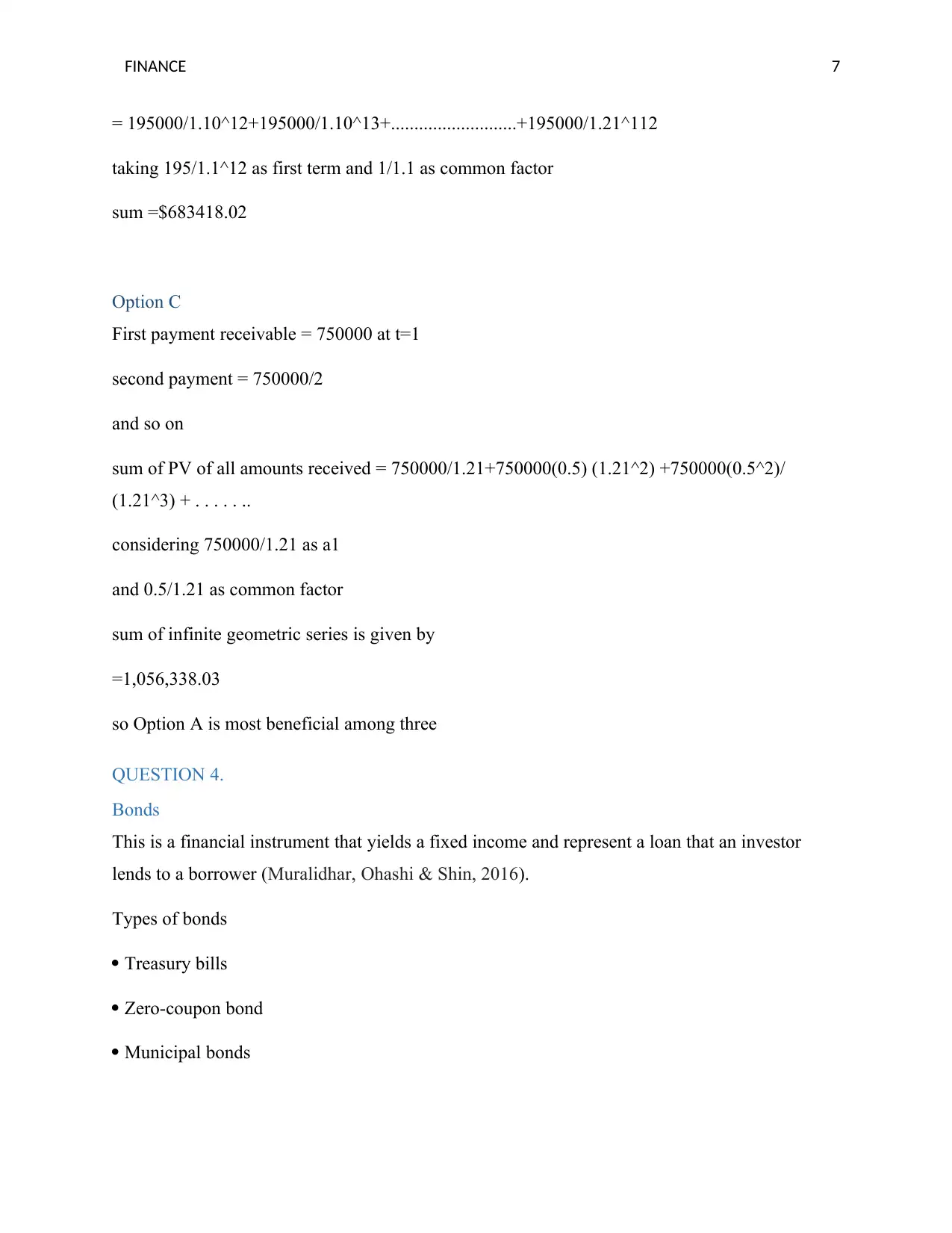
FINANCE 7
= 195000/1.10^12+195000/1.10^13+...........................+195000/1.21^112
taking 195/1.1^12 as first term and 1/1.1 as common factor
sum =$683418.02
Option C
First payment receivable = 750000 at t=1
second payment = 750000/2
and so on
sum of PV of all amounts received = 750000/1.21+750000(0.5) (1.21^2) +750000(0.5^2)/
(1.21^3) + . . . . . ..
considering 750000/1.21 as a1
and 0.5/1.21 as common factor
sum of infinite geometric series is given by
=1,056,338.03
so Option A is most beneficial among three
QUESTION 4.
Bonds
This is a financial instrument that yields a fixed income and represent a loan that an investor
lends to a borrower (Muralidhar, Ohashi & Shin, 2016).
Types of bonds
Treasury bills
Zero-coupon bond
Municipal bonds
= 195000/1.10^12+195000/1.10^13+...........................+195000/1.21^112
taking 195/1.1^12 as first term and 1/1.1 as common factor
sum =$683418.02
Option C
First payment receivable = 750000 at t=1
second payment = 750000/2
and so on
sum of PV of all amounts received = 750000/1.21+750000(0.5) (1.21^2) +750000(0.5^2)/
(1.21^3) + . . . . . ..
considering 750000/1.21 as a1
and 0.5/1.21 as common factor
sum of infinite geometric series is given by
=1,056,338.03
so Option A is most beneficial among three
QUESTION 4.
Bonds
This is a financial instrument that yields a fixed income and represent a loan that an investor
lends to a borrower (Muralidhar, Ohashi & Shin, 2016).
Types of bonds
Treasury bills
Zero-coupon bond
Municipal bonds
Paraphrase This Document
Need a fresh take? Get an instant paraphrase of this document with our AI Paraphraser
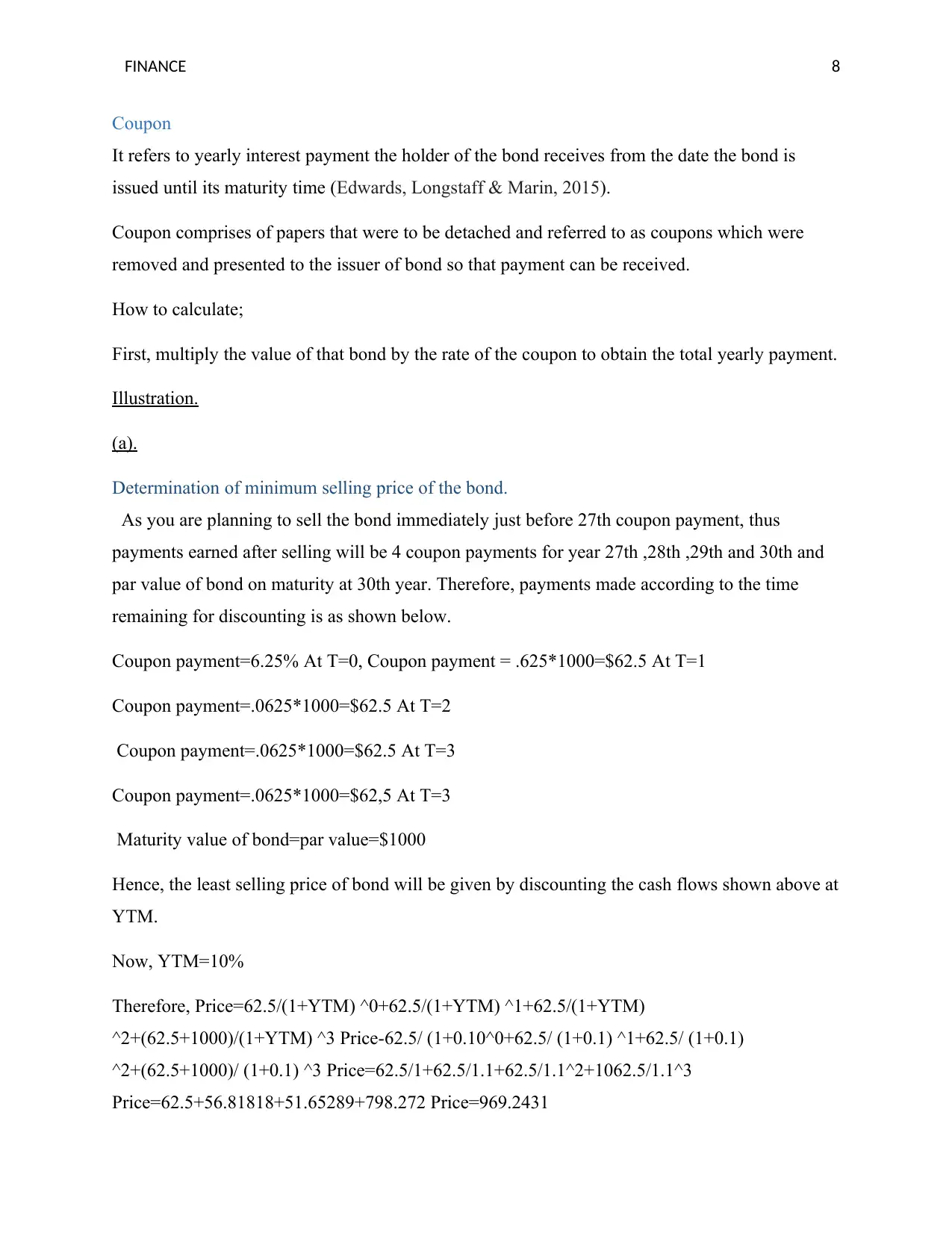
FINANCE 8
Coupon
It refers to yearly interest payment the holder of the bond receives from the date the bond is
issued until its maturity time (Edwards, Longstaff & Marin, 2015).
Coupon comprises of papers that were to be detached and referred to as coupons which were
removed and presented to the issuer of bond so that payment can be received.
How to calculate;
First, multiply the value of that bond by the rate of the coupon to obtain the total yearly payment.
Illustration.
(a).
Determination of minimum selling price of the bond.
As you are planning to sell the bond immediately just before 27th coupon payment, thus
payments earned after selling will be 4 coupon payments for year 27th ,28th ,29th and 30th and
par value of bond on maturity at 30th year. Therefore, payments made according to the time
remaining for discounting is as shown below.
Coupon payment=6.25% At T=0, Coupon payment = .625*1000=$62.5 At T=1
Coupon payment=.0625*1000=$62.5 At T=2
Coupon payment=.0625*1000=$62.5 At T=3
Coupon payment=.0625*1000=$62,5 At T=3
Maturity value of bond=par value=$1000
Hence, the least selling price of bond will be given by discounting the cash flows shown above at
YTM.
Now, YTM=10%
Therefore, Price=62.5/(1+YTM) ^0+62.5/(1+YTM) ^1+62.5/(1+YTM)
^2+(62.5+1000)/(1+YTM) ^3 Price-62.5/ (1+0.10^0+62.5/ (1+0.1) ^1+62.5/ (1+0.1)
^2+(62.5+1000)/ (1+0.1) ^3 Price=62.5/1+62.5/1.1+62.5/1.1^2+1062.5/1.1^3
Price=62.5+56.81818+51.65289+798.272 Price=969.2431
Coupon
It refers to yearly interest payment the holder of the bond receives from the date the bond is
issued until its maturity time (Edwards, Longstaff & Marin, 2015).
Coupon comprises of papers that were to be detached and referred to as coupons which were
removed and presented to the issuer of bond so that payment can be received.
How to calculate;
First, multiply the value of that bond by the rate of the coupon to obtain the total yearly payment.
Illustration.
(a).
Determination of minimum selling price of the bond.
As you are planning to sell the bond immediately just before 27th coupon payment, thus
payments earned after selling will be 4 coupon payments for year 27th ,28th ,29th and 30th and
par value of bond on maturity at 30th year. Therefore, payments made according to the time
remaining for discounting is as shown below.
Coupon payment=6.25% At T=0, Coupon payment = .625*1000=$62.5 At T=1
Coupon payment=.0625*1000=$62.5 At T=2
Coupon payment=.0625*1000=$62.5 At T=3
Coupon payment=.0625*1000=$62,5 At T=3
Maturity value of bond=par value=$1000
Hence, the least selling price of bond will be given by discounting the cash flows shown above at
YTM.
Now, YTM=10%
Therefore, Price=62.5/(1+YTM) ^0+62.5/(1+YTM) ^1+62.5/(1+YTM)
^2+(62.5+1000)/(1+YTM) ^3 Price-62.5/ (1+0.10^0+62.5/ (1+0.1) ^1+62.5/ (1+0.1)
^2+(62.5+1000)/ (1+0.1) ^3 Price=62.5/1+62.5/1.1+62.5/1.1^2+1062.5/1.1^3
Price=62.5+56.81818+51.65289+798.272 Price=969.2431
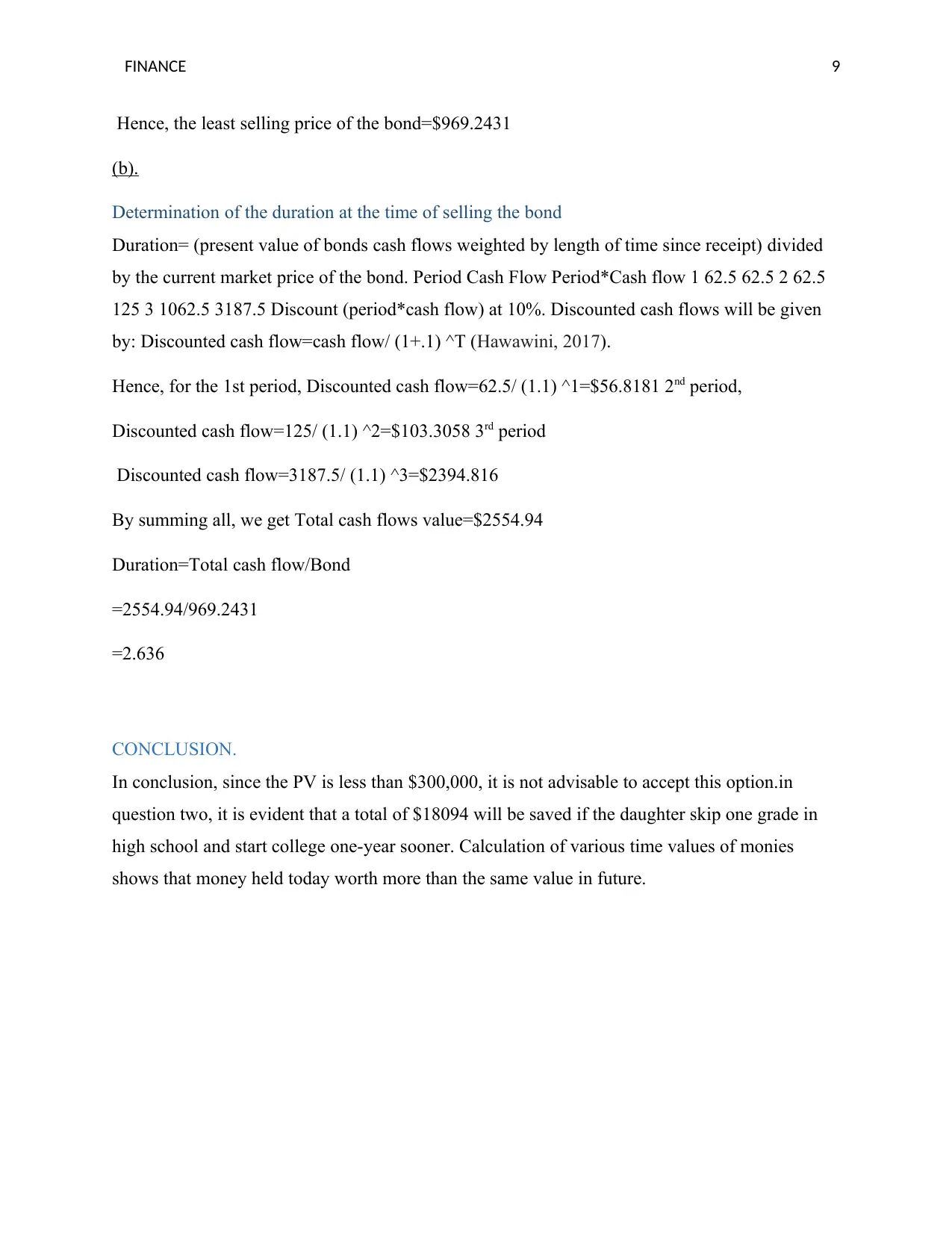
FINANCE 9
Hence, the least selling price of the bond=$969.2431
(b).
Determination of the duration at the time of selling the bond
Duration= (present value of bonds cash flows weighted by length of time since receipt) divided
by the current market price of the bond. Period Cash Flow Period*Cash flow 1 62.5 62.5 2 62.5
125 3 1062.5 3187.5 Discount (period*cash flow) at 10%. Discounted cash flows will be given
by: Discounted cash flow=cash flow/ (1+.1) ^T (Hawawini, 2017).
Hence, for the 1st period, Discounted cash flow=62.5/ (1.1) ^1=$56.8181 2nd period,
Discounted cash flow=125/ (1.1) ^2=$103.3058 3rd period
Discounted cash flow=3187.5/ (1.1) ^3=$2394.816
By summing all, we get Total cash flows value=$2554.94
Duration=Total cash flow/Bond
=2554.94/969.2431
=2.636
CONCLUSION.
In conclusion, since the PV is less than $300,000, it is not advisable to accept this option.in
question two, it is evident that a total of $18094 will be saved if the daughter skip one grade in
high school and start college one-year sooner. Calculation of various time values of monies
shows that money held today worth more than the same value in future.
Hence, the least selling price of the bond=$969.2431
(b).
Determination of the duration at the time of selling the bond
Duration= (present value of bonds cash flows weighted by length of time since receipt) divided
by the current market price of the bond. Period Cash Flow Period*Cash flow 1 62.5 62.5 2 62.5
125 3 1062.5 3187.5 Discount (period*cash flow) at 10%. Discounted cash flows will be given
by: Discounted cash flow=cash flow/ (1+.1) ^T (Hawawini, 2017).
Hence, for the 1st period, Discounted cash flow=62.5/ (1.1) ^1=$56.8181 2nd period,
Discounted cash flow=125/ (1.1) ^2=$103.3058 3rd period
Discounted cash flow=3187.5/ (1.1) ^3=$2394.816
By summing all, we get Total cash flows value=$2554.94
Duration=Total cash flow/Bond
=2554.94/969.2431
=2.636
CONCLUSION.
In conclusion, since the PV is less than $300,000, it is not advisable to accept this option.in
question two, it is evident that a total of $18094 will be saved if the daughter skip one grade in
high school and start college one-year sooner. Calculation of various time values of monies
shows that money held today worth more than the same value in future.
⊘ This is a preview!⊘
Do you want full access?
Subscribe today to unlock all pages.

Trusted by 1+ million students worldwide
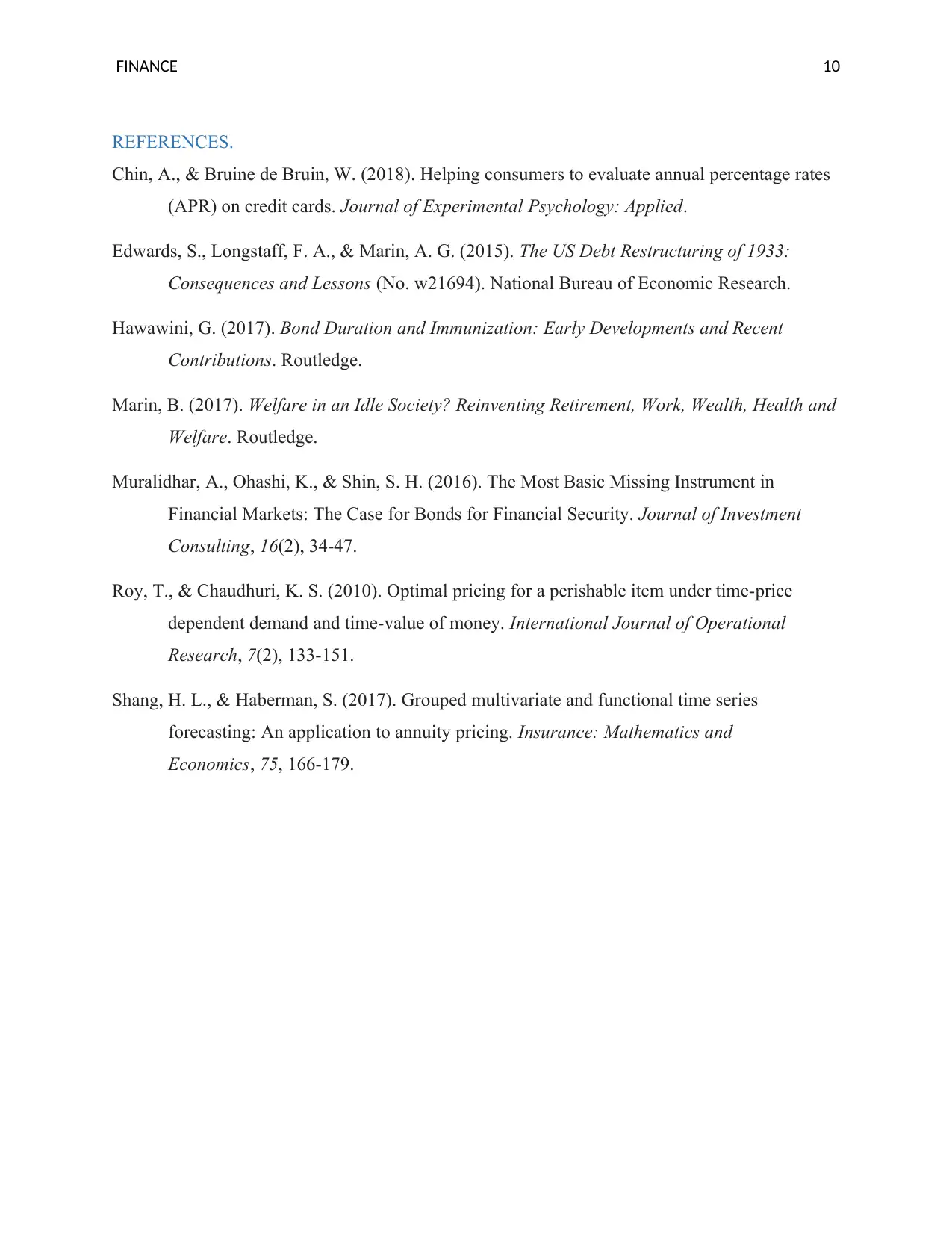
FINANCE 10
REFERENCES.
Chin, A., & Bruine de Bruin, W. (2018). Helping consumers to evaluate annual percentage rates
(APR) on credit cards. Journal of Experimental Psychology: Applied.
Edwards, S., Longstaff, F. A., & Marin, A. G. (2015). The US Debt Restructuring of 1933:
Consequences and Lessons (No. w21694). National Bureau of Economic Research.
Hawawini, G. (2017). Bond Duration and Immunization: Early Developments and Recent
Contributions. Routledge.
Marin, B. (2017). Welfare in an Idle Society? Reinventing Retirement, Work, Wealth, Health and
Welfare. Routledge.
Muralidhar, A., Ohashi, K., & Shin, S. H. (2016). The Most Basic Missing Instrument in
Financial Markets: The Case for Bonds for Financial Security. Journal of Investment
Consulting, 16(2), 34-47.
Roy, T., & Chaudhuri, K. S. (2010). Optimal pricing for a perishable item under time-price
dependent demand and time-value of money. International Journal of Operational
Research, 7(2), 133-151.
Shang, H. L., & Haberman, S. (2017). Grouped multivariate and functional time series
forecasting: An application to annuity pricing. Insurance: Mathematics and
Economics, 75, 166-179.
REFERENCES.
Chin, A., & Bruine de Bruin, W. (2018). Helping consumers to evaluate annual percentage rates
(APR) on credit cards. Journal of Experimental Psychology: Applied.
Edwards, S., Longstaff, F. A., & Marin, A. G. (2015). The US Debt Restructuring of 1933:
Consequences and Lessons (No. w21694). National Bureau of Economic Research.
Hawawini, G. (2017). Bond Duration and Immunization: Early Developments and Recent
Contributions. Routledge.
Marin, B. (2017). Welfare in an Idle Society? Reinventing Retirement, Work, Wealth, Health and
Welfare. Routledge.
Muralidhar, A., Ohashi, K., & Shin, S. H. (2016). The Most Basic Missing Instrument in
Financial Markets: The Case for Bonds for Financial Security. Journal of Investment
Consulting, 16(2), 34-47.
Roy, T., & Chaudhuri, K. S. (2010). Optimal pricing for a perishable item under time-price
dependent demand and time-value of money. International Journal of Operational
Research, 7(2), 133-151.
Shang, H. L., & Haberman, S. (2017). Grouped multivariate and functional time series
forecasting: An application to annuity pricing. Insurance: Mathematics and
Economics, 75, 166-179.
1 out of 10
Related Documents
Your All-in-One AI-Powered Toolkit for Academic Success.
+13062052269
info@desklib.com
Available 24*7 on WhatsApp / Email
![[object Object]](/_next/static/media/star-bottom.7253800d.svg)
Unlock your academic potential
Copyright © 2020–2025 A2Z Services. All Rights Reserved. Developed and managed by ZUCOL.





